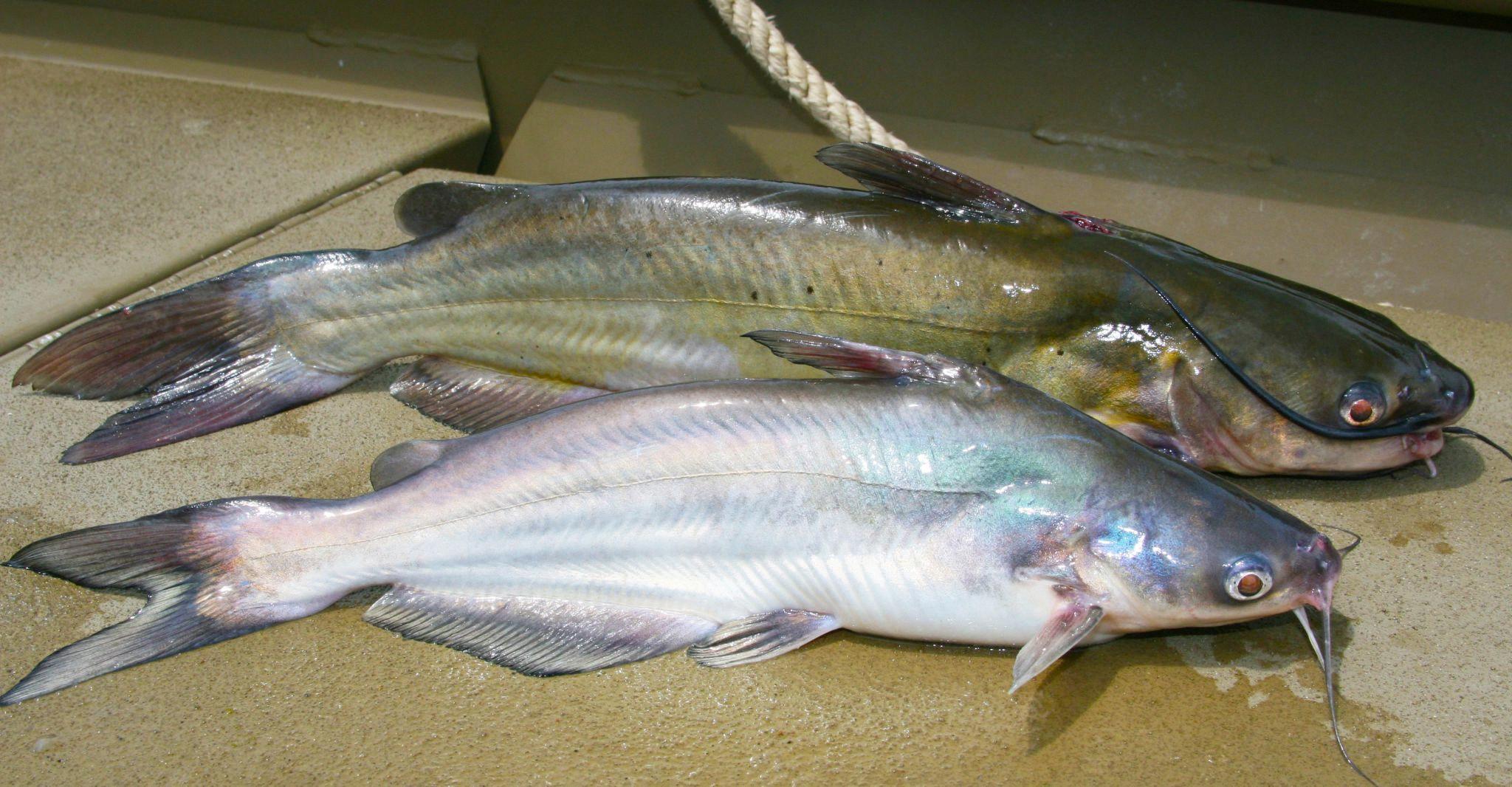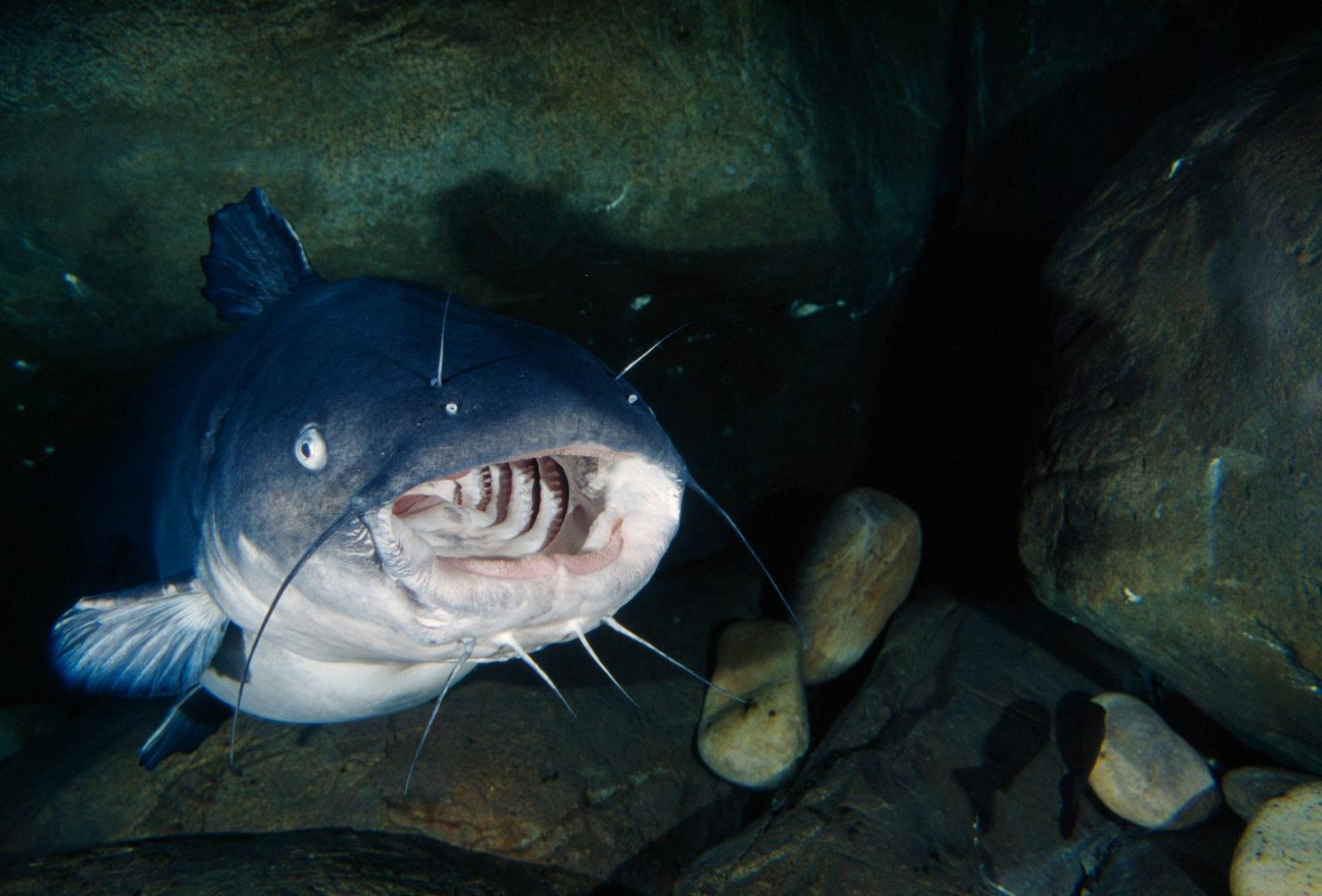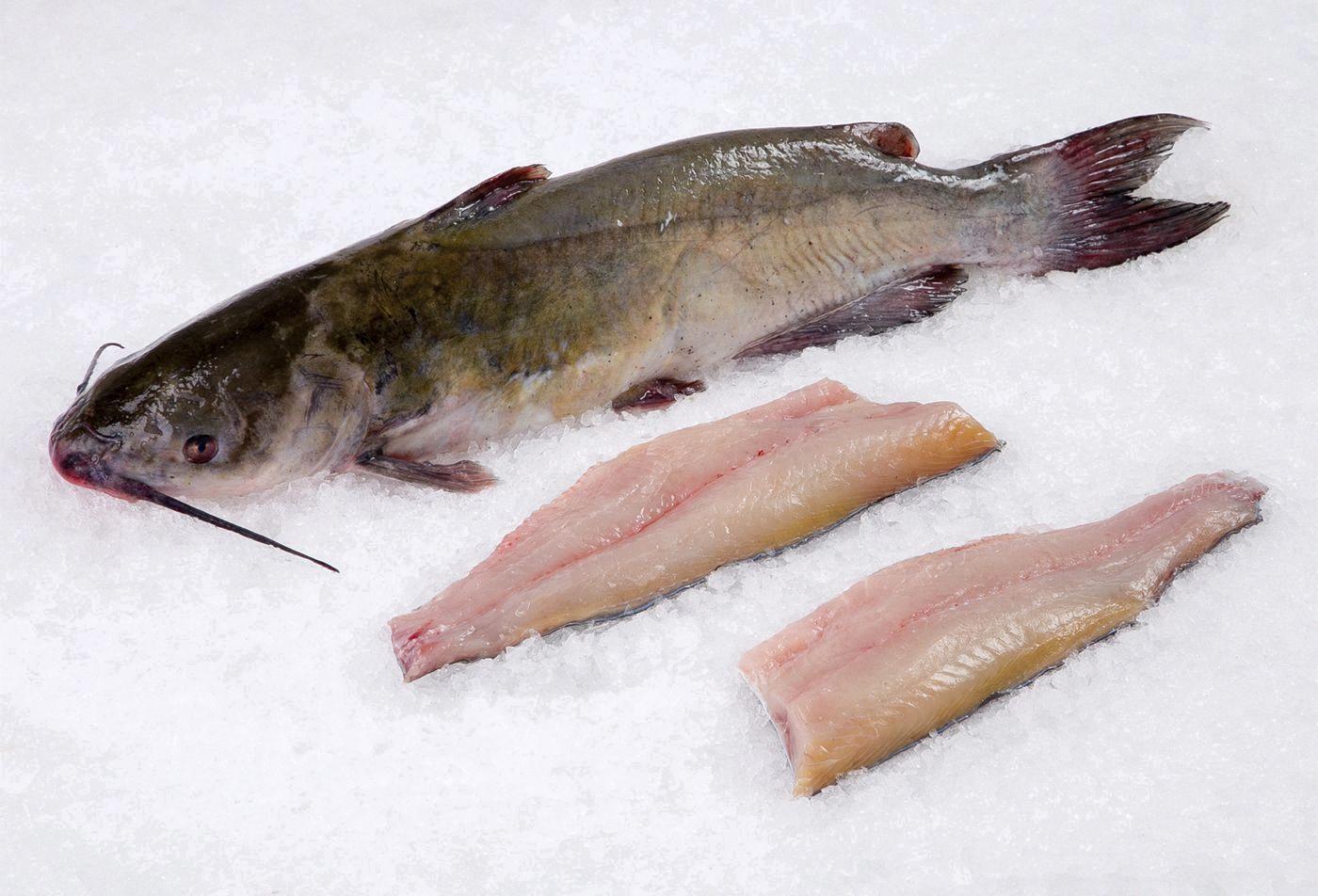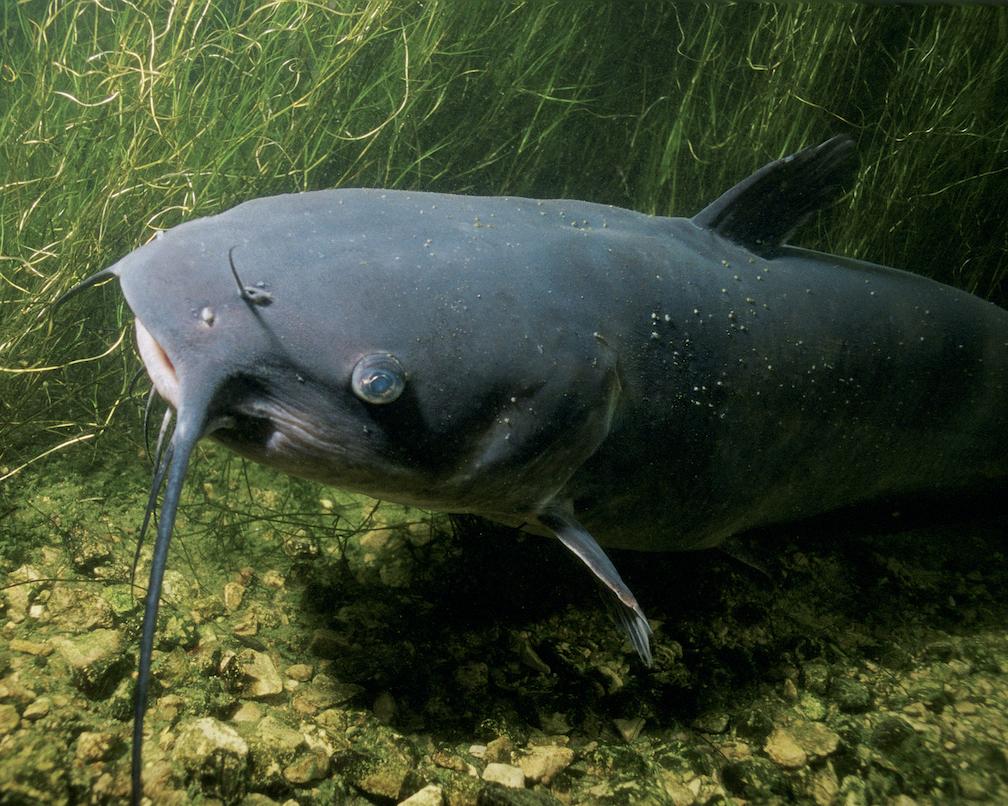Catfish are a diverse group of fish that are found in freshwater environments around the world. They are known for their whisker-like barbels that protrude from their mouths, whih they use to help them detect prey in murky waters. While most catfish species are relatively small, some can grow to be quite large, with the Mekong giant catfish being the largest exclusively freshwater fish ever recorded.
The Mekong giant catfish is native to the Mekong River basin in Southeast Asia and can reach lengths of up to 10 feet and weights of up to 650 pounds. These massive fish are filter feeders, subsisting on plankton and small aquatic organisms. Unfortunately, due to overfishing, habitat loss, and dam construction, the population of Mekong giant catfish has declined significantly in recent years, and they are now considered critically endangered.
While the Mekong giant catfish is the largest freshwater fish on record, other species of catfish can also grow to be quite large. For example, the wels catfish, which is found in Europe, can grow to be over 13 feet long and weigh over 600 pounds. In North America, the blue catfish and flathead catfish are two species that can reach impressive sizes, with the former reaching lengths of up to 5 feet and weights of up to 150 pounds, and the latter reaching lengths of up to 4 feet and weights of up to 100 pounds.
In addition to their impressive size, catfish are also valued for their meat, which is low in sodium and a good source of protein, vitamin D, vitamin B12, and phosphorus. They are popular among anglers, who often catch them using bait such as worms, minnows, and chicken liver.
Catfish are a fascinating group of fish that are found in freshwater environments around the world. While most species are relatively small, some can grow to be quite large, with the Mekong giant catfish being the largest exclusively freshwater fish ever recorded. Despite their impressive size, many species of catfish are under threat due to overfishing, habitat loss, and other human activities.
How Big Can Catfish Get?
The Mekong giant catfish is the largest catfish ever caught, acording to the Guinness Book of Records. This enormous fish was caught in northern Thailand in 2005 and weighed an astonishing 646 pounds. The individual catfish was also nine feet long, making it the largest exclusively freshwater fish ever recorded.
The Mekong giant catfish is a species native to Southeast Asia, specifically the Mekong River Basin. They are critically endangered, with populations declining due to overfishing, habitat loss, and dam construction. In fact, the 646-pound catfish caught in 2005 was likely one of the last remaining individuals of its kind in the wild.
Mekong giant catfish can grow up to 10 feet in length and weigh over 660 pounds, but individuals of this size are incredibly rare. They are bottom feeders, primarily eating plants and small aquatic animals, and can live up to 25 years.
The Mekong giant catfish is the largest catfish ever caught, with a record-breaking individual weighing 646 pounds and measuring nine feet long. While these fish are incredibly impressive, they are also critically endangered and in need of conservation efforts to prevent their extinction.

Source: houstonchronicle.com
The Largest Growing Type of Catfish
The Mekong giant catfish is the type of catfish that grows to the largest size. This prticular species of catfish can reach up to 9 feet (2.7 meters) in length and weigh as much as 646 pounds (293 kilograms). Experts believe that this fish may be the largest freshwater fish ever recorded.
The Mekong giant catfish is native to Southeast Asia, specifically the Mekong River basin. It is a critically endangered species due to overfishing, habitat loss, and dam construction.
This type of catfish is a bottom feeder, meaning it primarily eats small fish, crustaceans, and other aquatic creatures found at the bottom of rivers and lakes. They are also known for their migratory behavior, swimming upstream to spawn in the shallower waters of the river.
It’s important to note that while the Mekong giant catfish is the largest type of catfish, there are many other species of catfish that can also grow to impressive sizes. Some of these include the wels catfish, the flathead catfish, and the blue catfish.
The Largest Catfish Ever Caught in the United States
The largest catfish ever caught in the United States is a 58-pound channel catfish. This impressive fish was caught on July 7, 1964, in the Santee-Cooper Reservoir in South Carolina. The catch was officially recognized as the all-tackle world record for channel catfish. The fish measured 47.25 inches in length and had a girth of 29 inches.
The Santee-Cooper Reservoir is knwn for its large catfish population, and it is a popular destination for catfish anglers. The channel catfish is one of several species of catfish found in the reservoir, and it is known for its excellent table fare.
It is worth noting that while the 58-pound channel catfish is the largest catfish ever caught in the United States, there have been reports of larger catfish caught in other parts of the world. For example, the Mekong giant catfish, found in Southeast Asia, can grow to be over 600 pounds. However, these fish are not found in the United States and are not typically targeted by American anglers.
The 58-pound channel catfish caught in the Santee-Cooper Reservoir remains a remarkable catch and a testament to the size and strength of this species of catfish.
The Edibility of Catfish
Catfish are good to eat, and they are also very nutritious. Catfish is a type of freshwater fish that is widely consumed around the world. It is a low-fat, low-calorie source of protein that is also rich in essential vitamins and minerals. Here are some of the key nutritional benefits of eating catfish:
– Protein: Catfish is a very good source of protein, which is essential for building and repairing muscle tissue. A 3-ounce serving of catfish povides about 15 grams of protein, which is about 30% of the recommended daily intake for an adult.
– Vitamin B12: Catfish is a rich source of vitamin B12, which is important for maintaining healthy nerve cells and red blood cells. A 3-ounce serving of catfish provides about 2.5 micrograms of vitamin B12, which is more than 100% of the recommended daily intake for an adult.
– Vitamin D: Catfish is one of the few food sources of vitamin D, which is important for maintaining strong bones and teeth. A 3-ounce serving of catfish provides about 200 international units (IU) of vitamin D, which is about 50% of the recommended daily intake for an adult.
– Potassium: Catfish is a good source of potassium, which is important for regulating blood pressure and maintaining proper fluid balance in the body. A 3-ounce serving of catfish provides about 300 milligrams of potassium, which is about 10% of the recommended daily intake for an adult.
– Selenium: Catfish is a good source of selenium, which is important for maintaining a healthy immune system and protecting against oxidative damage. A 3-ounce serving of catfish provides about 20 micrograms of selenium, which is about 30% of the recommended daily intake for an adult.
Catfish is a nutritious and delicious food that can be enjoyed as part of a healthy diet. It is rich in protein, vitamin B12, vitamin D, potassium, and selenium, all of which are essential nutrients for optimal health.
The World’s Largest Fish
The world’s largest fish is the Rhincodon typus, commonly known as the whale shark. These massive creatures can grow up to 40 feet long and weigh up to 20 tons, making them not only the largest fish but also one of the largest animals in the world.
Whale sharks have a distinctive appearance with a wide, flat head and a mouth that can stretch up to four feet wide. They have a unique pattern of pale yellow spots and stripes on their dark grey or brown skin, which is covered in a layer of protective mucus.
Despite their intimidating size and appearance, whale sharks are generally harmless to humans. They are filter feeders, meaning that they feed on plankton and small fish by swimming through the water with their mouths open. This also makes them docile and approachable, making them a popular attraction for divers and snorkelers in some parts of the world.
Whale sharks are found in warm, tropical waters arond the world, including in the Indian and Pacific Oceans and the Caribbean Sea. They are considered a vulnerable species due to threats such as overfishing and accidental entanglement in fishing gear.
To help protect whale sharks, conservation efforts are underway to monitor their populations, reduce fishing pressure, and educate the public about the importance of these gentle giants.

Source: washingtonpost.com
What Lures Big Catfish?
Catfish are known to be opportunistic feeders and can eat almost anything. However, to attract big catfish, it’s important to use the right bait. Here are some of the best baits to attract big catfish:
1. Live Bait: Live baits like shad, bluegill, and minnows are highly effective in attracting big catfish. The movement of live bait in the water can trigger the predatory instincts of catfish, making them more likely to strike.
2. Cut Bait: Cut bait is another popular bait for catfish. It refers to pieces of fish cut into small chunks and used as bait. Fresh-cut bait like skipjack or shad works best, as it releases a strong scent that can attract catfish from far away.
3. Stink Bait: Stink bait, also known as dip bait, is a type of bait that emits a strong odor that catfish can’t resist. It’s made from a variety of ingredients such as cheese, blood, and chicken livers. Stink bait is typically used in shallow water or small ponds whee catfish are known to congregate.
4. Worms and Nightcrawlers: Worms are classic catfish bait and are readily available at most bait and tackle shops. Nightcrawlers are a type of worm that is larger and more attractive to big catfish. They are best used in slow-moving water or in areas with dense vegetation.
5. Chicken Liver: Chicken liver is another popular bait for catfish. It’s cheap, readily available, and releases a strong scent that catfish can detect from far away. Chicken liver works best in warm water conditions or in areas where catfish are known to be feeding actively.
Big catfish can be attracted to a variety of baits, but live bait, cut bait, stink bait, worms, and chicken liver are some of the most effective options. Using these baits in the right conditions and locations can significantly increase your chances of catching big catfish.
Factors That Impact the Growth of Catfish
Catfish is one of the most popular aquaculture species due to its high nutritional value and delicious taste. However, the growth rate of catfish can vary depending on seeral factors such as water quality, feed quality, and stocking density. In this article, we will discuss the factors that can help catfish grow faster and bigger.
1. Feed quality: Providing high-quality feed is crucial for the growth and development of catfish. Feeds that contain a balanced ratio of protein, fat, and carbohydrates can promote fast growth and improve the feed conversion ratio (FCR). Fishmeal, soybean meal, and wheat bran are some of the common ingredients used in catfish feeds.
2. Water quality: Optimal water quality is necessary for the growth and survival of catfish. Water temperature, dissolved oxygen, pH, and ammonia levels should be maintained within the recommended range. Poor water quality can lead to stress, disease, and slow growth.
3. Stocking density: Stocking density refers to the number of catfish per unit area of water. Overcrowding can lead to competition for resources, increased stress, and slower growth. Therefore, it is essential to maintain a proper stocking density to ensure optimal growth and reduce stress.
4. Biofloc technology: Biofloc technology is a sustainable aquaculture practice that involves the use of microbial communities to convert organic matter into protein-rich biomass. The inclusion of biofloc meal in catfish feed has been shown to improve growth, feed utilization, and health status. Additionally, biofloc technology can reduce the need for water exchange and minimize the environmental impact of aquaculture.
5. Genetics: Selective breeding can enhance the growth rate and size of catfish. Breeding programs that focus on desirable traits such as fast growth, disease resistance, and high-quality flesh can lead to the development of superior catfish strains.
Catfish growth and size can be influenced by several factors such as feed quality, water quality, stocking density, biofloc technology, and genetics. By implementing these practices, catfish farmers can improve the growth rate and profitability of their operations.
Attracting Large Catfish
Catfish are known to be bottom feeders, and they are attracted to food by both sight and smell. Therefore, it is essential to understand what they are attracted to in order to increase your chances of catching them. Here are some factors that attract large catfish:
1. Bright colors: Catfish are attracted to bright colors such as orange or red. Therefore, using lures that have these colors can help attract them. You can also use bait that has a bright color to increase your chances of attracting them.
2. Smell: Catfish have a strong sense of smell, and they are attracted to the smell of food. Therefore, using bait that has a strong scent can help attract them. Some of the best baits to use include chicken liver, shrimp, and cut bait.
3. Texture: Catfish are known to be opportunistic feeders, and they are attracted to anyting that looks like food. Therefore, using bait that has a texture similar to their natural prey can help attract them. Some of the best baits to use include worms, crayfish, and minnows.
4. Location: Catfish are more likely to be found in areas with a lot of cover, such as under logs or in deep holes. Therefore, fishing in these areas can help increase your chances of catching them.
Understanding what attracts large catfish is crucial if you want to increase your chances of catching them. Using bright colors, strong scents, and baits that have a texture similar to their natural prey can help attract them. Additionally, fishing in areas with a lot of cover can also help increase your chances of catching them.
The Record-Breaking Freshwater Fish Catch
The biggest freshwater fish ever caught was a massive freshwater stingray. This record-breaking catch occurred on June 13, and the weight of the stingray was confirmed to be a staggering 661 pounds. This weight sets a new world record for the largest freshwater fish ever caught.
Freshwater stingrays are not commonly found in the wild and are typically found in South America and Southeast Asia. These fish are knwn for their unique appearance and large size, making them a popular target for fishing enthusiasts.
The previous record for the largest freshwater fish ever caught was held by a Mekong giant catfish, which weighed in at 646 pounds. This fish was caught in Thailand in 2005.
It is important to note that catching large fish, such as the freshwater stingray, requires a lot of skill and experience. Fishing for these types of fish can also be dangerous, so it is important to take proper safety precautions and follow all regulations and guidelines.
The biggest freshwater fish ever caught was a 661-pound freshwater stingray, which set a new world record. This catch highlights the unique and impressive nature of these fish and the skill required to catch them.

Source: citarella.com
The State with the Largest Catfish Population
When it comes to catching big catfish, Mississippi is one of the top states to consider. The state is home to the Mississippi River, which runs for 410 miles along its western border, and is known for producing trophy-sized catfish.
In fact, Mississippi holds the state records for both blue and flathead catfish. The largest blue catfish caught in Mississippi weighed in at a whopping 95 pounds, while the largest flathead catfish weighed 77.7 pounds. These impressive catches are a testament to the abundance and size of catfish in the state’s waters.
While the Mississippi River is a prime location for catfish, it’s not the only spot to consider. Other popular fishing destinations in Mississippi include Sardis Lake, Arkabutla Lake, and Ross Barnett Reservoir, all of which have produced their fair share of record-breaking catfish.
So, if you’re looking to catch the biggest catfish possible, Mississippi is defnitely a state worth considering. With its ample fishing opportunities and impressive records, it’s no wonder why so many anglers flock to its waters each year.
The Largest Freshwater Fish in the World
Sturgeon are a family of fish that are considered to be the largest of all freshwater fish. Among them, the beluga sturgeon is knwn to be the largest freshwater fish in the world. This species of sturgeon can be found in the waters of Russia and can grow up to 20 feet in length and weigh as much as 3,500 pounds.
The beluga sturgeon is known for its distinctive appearance, which includes a long, pointed snout, a broad head, and a dark grey or black body. It is also known for its prized caviar, which is considered to be one of the finest in the world.
The white sturgeon, which is found in North America, is the largest freshwater fish on this continent. This fish can grow up to 15-20 feet in length and weigh up to 1 ton. The white sturgeon is found in several major rivers in North America, including the Columbia River, the Fraser River, and the Sacramento River.
Sturgeon are known for their longevity, with some individuals living for more than 100 years. They are also slow-growing fish, with females reaching sexual maturity only after 15-20 years. Due to overfishing and habitat destruction, many species of sturgeon are now endangered or critically endangered, and their populations continue to decline.
The beluga sturgeon is the largest freshwater fish in the world, while the white sturgeon is the largest freshwater fish in North America. Both species are highly valued for their meat and caviar, but unfortunately, their populations are threatened by human activities.
The Risks of Catfish Bites
If a catfish bites you, it may not necessarily be harmful, but their skin toxin and venomous spines can cause a painful sting that can lead to severe tissue necrosis. The hand is the most commonly affected body part in catfish stings.
Catfish skin toxin and venomous spines can cause a range of symptoms, including:
– Pain: Stinging pain at the site of the sting is common.
– Swelling: The affected area may swell up and become red.
– Tissue necrosis: In rare cases, severe tissue necrosis may occur, whih can lead to the death of skin and muscle tissue.
If you are stung by a catfish, it is essential to seek medical attention immediately. In some cases, the sting may require surgical intervention to remove any remaining spines or to treat the area affected by tissue necrosis.
To avoid getting stung by a catfish, it is important to take precautions such as wearing protective clothing, handling them with care, and avoiding touching their spines. If you are fishing, use pliers or a de-hooking tool to remove the hook from the fish’s mouth instead of using your hands.
While not all catfish bites are harmful, it is crucial to take precautions and seek medical attention if you experience any symptoms after being stung by a catfish.
What Is the Most Delicious Fish?
When it comes to the best tasting fish, there are several options to choose from. However, taste is subjective and can vary from person to person. That said, there are a few types of fish that are widely regarded as delicious.
Cod is a popular choice due to its mild, milky flavor. It’s also a versatile fish that can be cooked in a variety of ways, such as baked, fried, or grilled. Sole is another mild fish with a slightly sweet taste. It’s oten used in dishes like fish and chips or as a substitute for other white fish.
Halibut is a meaty fish with a sweet taste that’s highly sought after in the culinary world. It’s often served grilled or baked and pairs well with a variety of sauces and seasonings. Sea bass is another mild fish that’s delicate in both texture and flavor. It’s often served in fine dining restaurants and is a popular choice for ceviche.
Trout is a freshwater fish with a slightly nutty flavor that’s often compared to salmon. It’s a popular choice for smoking or grilling and pairs well with herbs like dill or rosemary. Speaking of salmon, it’s a fan-favorite due to its rich, buttery taste and flaky texture. It’s often cooked in a variety of ways, such as baked, grilled, or smoked.
The best tasting fish can vary from person to person, but cod, sole, halibut, sea bass, trout, and salmon are all highly regarded for their delicious taste profiles.

Source: mississippiencyclopedia.org
What is the Optimal Size for Eating Catfish?
When it comes to eating catfish, there’s no doubt that the size matters. Generally, the best size for eating is around 3-5 pounds. However, this might vary depending on personal taste and preference. Some people might prefer smaller fish, while others might like bigger ones.
It’s worth noting that younger catfish tend to be better for eating than the bigger ones. This is because big catfish tend to accumulate toxins in their systems, which can make them unsafe for consumption. Therefore, it’s recommended to stick to smaller catfish if you’re looking for the best taste and quality.
If you’re planning to catch catfish for eating, it’s important to keep in mind that there are regulations in place to protect the species. Make sure to check with your local fishing authorities to find out the size limits and other rules reated to catfish fishing.
The best size of catfish for eating is around 3-5 pounds. However, it’s important to consider personal preference and ensure that you’re following the regulations related to catfish fishing in your area.
Conclusion
The Mekong giant catfish truly is a remarkable creature. As the largest exclusively freshwater fish ever recorded, it is truly an impressive feat of nature. With a length of nealy nine feet and a weight of over 600 pounds, it is easy to see why this fish is such a popular topic of discussion among fishermen and nature enthusiasts alike.
Not only is the Mekong giant catfish impressive in size, but it also provides a great source of nutrition. Catfish is low in sodium, high in protein, and contains vitamins and minerals such as thiamin, potassium, selenium, vitamin D, vitamin B12, and phosphorus. This makes it a great addition to any healthy diet.
However, it is important to remember that the Mekong giant catfish is an endangered species. Overfishing and habitat destruction have led to a decline in their population, and it is important that we take action to protect these magnificent creatures.
The Mekong giant catfish is a true wonder of nature. It is the largest exclusively freshwater fish ever recorded and provides a great source of nutrition. However, we must also remember to take steps to protect this endangered species and ensure that it continues to thrive for generations to come.
